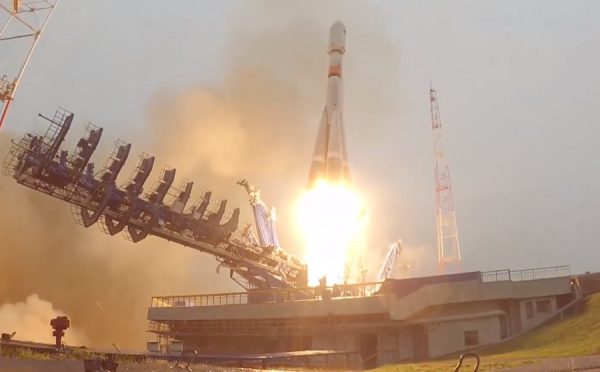Russia launches missile warning satellite – Spaceflight Now


A Russian military satellite designed to detect missile launches arrived in orbit Thursday following a successful liftoff aboard a Soyuz rocket from the Plesetsk Cosmodrome.
The Russian Defense Ministry said a Soyuz-2.1b rocket, topped with a Fregat upper stage, launched from the Plesetsk Cosmodrome in northern Russia at 0746 GMT (3:46 a.m. EDT) Thursday carrying a military payload.
A statement from the Russian Defense Ministry did not identify the payload, but information about the mission’s trajectory released in warning notices to pilots and mariners suggested the satellite was likely the third EKS, or Tundra, missile warning satellites for the Russian military.
Orbital tracking data released by the U.S. military showed Thursday’s launch delivered its payload into an elliptical orbit inclined 63.8 degrees to the equator, with altitudes ranging from around 1,022 miles (1,645 kilometers) to 23,945 miles (38,536 kilometers) above Earth.
The egg-shaped, or Molniya-type, orbit matches the orbits of the first two EKS-class early warning satellites launched on Soyuz/Fregat rockets in November 2015 and May 2017.
The Soyuz-2.1b rocket flew southeast from Plesetsk and dropped its four liquid-fueled first stage boosters around two minutes after liftoff. The launcher later shed its payload fairing and core stage, and the Soyuz third stage deployed a Fregat upper stage on a suborbital trajectory around nine minutes into the mission.
The Fregat upper stage fired multiple times to place its satellite payload into the targeted orbit, and the spacecraft separated from the Fregat space tug several hours after liftoff.
The Russian Defense Ministry said ground controllers established a “stable telemetric connection” with the spacecraft. Systems on-board the satellite are functioning normally, the defense ministry said.
Thursday’s launch deployed the third EKS, or Tundra, early warning satellite to orbit. The new generation of EKS satellites replace Russia’s Oko series of missile warning spacecraft, the last of which launched in 2012.
Russia uses the missile warning satellites, along with ground-based radars, to track missiles that approach the country’s territory. The Molniya-type orbits used by the EKS satellites give the spacecraft’s thermal infrared sensors long views over the northern hemisphere on each 12-hour loop around Earth.
The orbits provide the satellites the ability to detect missile launches from North America, and detect incoming missiles that threaten Russian territory.
The Russian Defense Ministry named the new satellite Kosmos 2541, keeping with the Russian military’s naming scheme for military spacecraft.
Email the author.
Follow Stephen Clark on Twitter: @StephenClark1.






